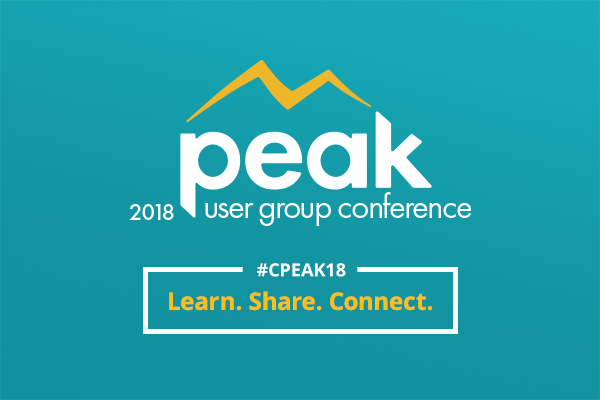
by Rich Finstein | Apr 5, 2018 | Blog
A year ago we made the decision to host our first User Conference. Since this was our initial event, we had some trepidation about whether our community would embrace the opportunity to join us for several days of education, training and networking. Our decision to move forward was quickly validated as we reached the maximum number of attendees we could accommodate in the venue.
When the first day of the conference arrived, we were excited to see in-person the people we interact with on a daily basis. As I began the initial welcome, I mentioned to the group that this felt more like a social function as opposed to a business event. There was a warm feeling that comes when relationships evolve over time and there is continuity of working with the same team to share opportunities and solve problems. For our team, this conference was an important barometer of where we stand. It’s one thing to have one on one interactions, however it’s an entirely different situation to see many of your clients in one setting. We feel extremely blessed to have had this opportunity.
There are three insights that we walked away with from the event:
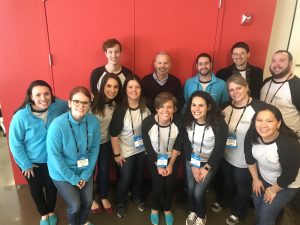
Click to view photos from Peak 2018.
- We have a vibrant community that has evolved organically with us over a long period of time. There are no shortcuts in getting to this point. CommPartners has an average employee tenure of 8 years with many staff being with us for 12 to 15 years. At times, we don’t think about how important a factor this is in building close client relationships that lead to greater continuity and trust. You could witness this in real time during the conference.
- Peak served an important purpose of facilitating ideas and proving attendees practical applications they can implement today. One of the greatest benefits was the sharing of best practices and hearing how people in the same position overcome day to day challenges of managing professional development within their organizations. We realized we need to keep this conversation going and not wait until we meet again. Therefore, we launched a number of initiatives to give voice to our clients and allow for ongoing engagement. They include:
- Elevate Advisory Board: This is a 13 member panel group made up of mostly clients to provide guidance and feedback on Elevate’s development, provide feedback on our services and share ideas with other Board members.
- CommPartners Mastermind Groups: These groups bring clients together for 4 sessions to engage around topics of leadership, creative thinking and professional growth.
- CP Connect Community: CP Connect is an online community. It will be launching shortly to continue the conversations and sharing of ideas that occurred at Peak.
- CP Cares: We are expanding our altruistic initiatives to support those in need. We are hoping to involve our clients in these efforts.
- We need to continuously come through for our community. You depend on us. This was evident through the passionate conversations that occurred at the conference. We understand this responsibility. In the coming year we have aggressive plans to bring innovation, additional resources and service enhancements to our clients. We’re excited about growing with you and helping you succeed.
If you have any additional feedback or thoughts about Peak or any other items, please contact me.
All the Best,

Rich Finstein
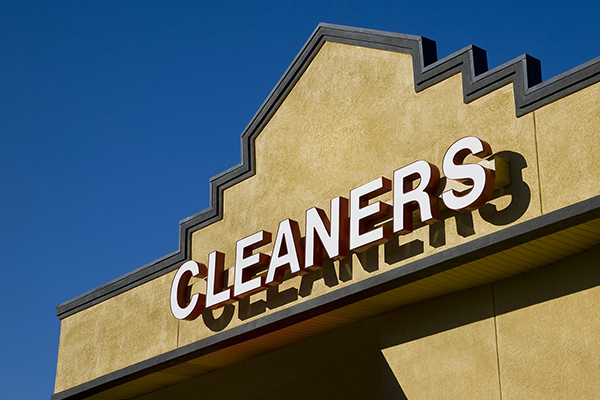
by Rich Finstein | Feb 9, 2018 | Blog
Last year was a period of great movement with technology providers within our community. There was an increase in merger and acquisition activity as organizations sought to extend their presence and gain strategic advantages and market share. While some may tout that bigger is always better when it comes to technology, there is a flipside to the equation. Some mergers or acquisitions do in fact work out very well for the customer however there are others that primarily benefit the company.
I began thinking about all the examples of where bigger or well-funded is not better. One service I and many others use on a weekly basis is dry cleaning. Several years ago Zips, the well-funded, national cleaners came up with a new pricing plan where they were going to charge the same low fee for every garment and promise same day service. Hearing this, I left my local cleaners, the one I went to for years, whose name literally is “Cleaners” to try this new concept. After all, Zips had a big presence; they were growing and seemed to offer great value.
After being with Zips for six months, I just recently returned to my local option. Zips always had long lines, they damaged some of my clothes, and the staff changed often. I never got to know them or build trust. In the end, it cost me more and I was treated like a number, not a loyal, valued customer. Returning to “Cleaners” I now get in and out quickly and my clothes are nicely cared for and returned in great condition. Not to mention, I am greeted with the same friendly face each time I return.
So what does dry cleaning have to do with technology? Not much really… except that for associations, trust, understanding, and continuity are significant factors when choosing a strategic partner. The best technology option is the company that allows you to successfully meet your objectives.
When considering a new LMS technology partner, be sure to ask meaningful questions such as:
- What percentage of your budget goes into the development of your software or services vs sales, marketing or distribution to shareholders?
- How would you define your company culture? Will the people I am speaking with today, who are making promises, be here tomorrow?
- What challenges are you currently addressing? How does your solution make my organization better?
- Have you recently been involved in a merger or acquisition? Can you describe how this will affect your current product or service offerings?
We have seen examples when mergers occur, the people you built trust with are gone and the platform or solutions you are invested in are no longer evolving. At CommPartners we have grown organically and with a shared purpose with our staff and extended community. We believe strongly in a culture of responsiveness, centered on the client.
Yes, many mergers or acquisitions, when handled well can greatly benefit the client and simply makes sense. However to say in all cases that bigger is better is just not true. Thank you “Cleaners” for always being there. Sorry I was swayed by bigger is always better.
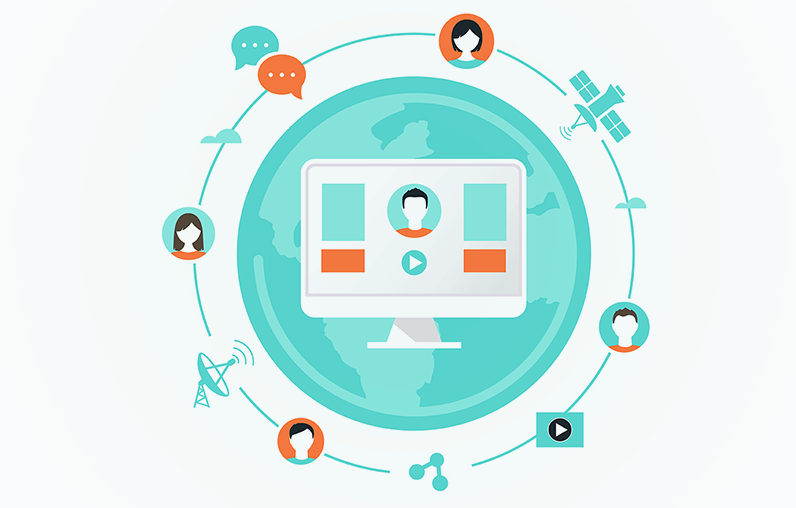
by Rich Finstein | Nov 13, 2017 | Blog
At the 2017 Higher Logic Super Forum, I along with an association colleague, facilitated a session on the virtues of developing an integrated approach for bringing together online community engagement and an LMS in a single offering. During the session, we discussed how associations typically have these areas configured as unique components. In reality, both provide opportunities for learning. Since an online community engagement strategy is usually focused on facilitating peer collaboration, and the learning management system (LMS) provides expert content, it’s natural they come together to support the stakeholder experience in a synergistic way.
A key connector in this relationship are live online events and webinars. Traditionally, live events and webinars have been positioned on their own through a registration and authentication page provided by the webinar vendor or a separate catalog of programs. A better, more engaging approach is to promote and provide access to these events within a private community.
Here are 5 considerations for using live, online events and webcasts to increase the impact of your online community engagement strategy:
- Registration will feel like a continuum of existing collaboration. Participants who have already been invested in the topic can now be encouraged, in an intuitive way, to take the step to register and participate in online discussions.
- Participation from new and non-engaged members is encouraged with an integrated approach. Live, online events and webinars are tangible ways to draw participants to specific areas of your Web presence. Offering them through a dedicated part of your LMS gives users a reason to create a profile and begin to participate in other social learning and online community engagement opportunities.
- Leverage interaction before and after an online event or webcast. Participants should be able to see who is attending, exchange ideas, and engage the presenters before the event. Afterward, users can continue any conversations that may have been cut short (which happens often!) during an hour program.
- Integrate results from live event and webinar attendance with other participation metrics, providing a complete picture of online community engagement. Host organizations will appreciate having a central repository to evaluate participation outcomes.
- Award badges or ribbons for participation or achievement from webinars in the same area where recognition is provided for other activities. Providing recognition will further encourage participation in future live, online events.
We see webinars and live events becoming much more collaborative and transparent. Bringing them into your online community is a natural way to build participation and provide synergy with your other educational objectives.
If you have interest in learning more about integrating events and webinars with your community contact us online, or email Meghan Gowen at mgowen@commpartners.com.
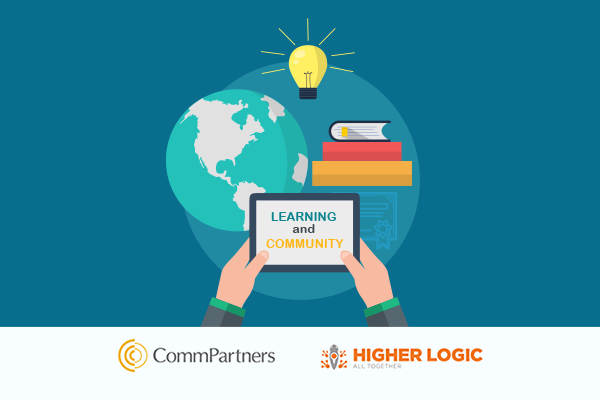
by Rich Finstein | Sep 25, 2017 | Blog
It has been almost a year since CommPartners and Higher Logic began formally collaborating with the premise that learning in its many forms is a natural extension of community engagement. This concept is not new for most of us. I remember many conversations that took place at ASAE Annual Conferences and other meetings over the years about the virtues of social learning. Everyone agreed that the notion of peer to peer, sharing of ideas should accompany and be integrated with knowledge shared by experts. After all, when we think of the best learning experiences, it’s typically a conference with our community peers. We value the sessions but a significant part of our reason for attending is the knowledge we receive from colleagues. So why is online learning experiences so segmented?
While in theory this sounded like a wise idea, the execution of social learning was slow to take hold. There are likely many reasons for this, but the lack of an online platform that truly enabled Web based social experiences was not helping to forge the way.
Last year, Higher Logic and CommPartners’ teams got together to identify how we could make community driven learning a reality. We had certain ideas and it took quite an investment of time to identify how this could work. Our first success was the creation of Higher Logic’s Online Academy courses. This training enables participants to sign up and participate in a self-paced training program (powered through our learning management system, Elevate LMS) within the community. Completion of courses is reported to Higher Logic’s activities area, giving the community member and the host organization, in this case Higher Logic, a more holistic report of engagement that was taking place.
After this initial success, our efforts turned towards helping associations realize the benefits of bridging their Learning Management System and community to offer their stakeholders an integrated experience. As the discussions evolved, one question became clear; why are we asking our participants to navigate to two separate and distinct areas of a website when both areas provide opportunities for learning? Shouldn’t the synergy between these two components be together? So we went to work and came up with a fully integrated platform both visually and programmatically.
Key elements of Higher Logic’s community and CommPartners Elevate Learning Management System now work together, prioritizing the participant experience. Twelve months later we have many organizations that have embraced this integrated approach and we have certainly learned a lot. Here are four key lessons learned from bridging these two areas:
1. In many cases organizations still need a strong, independent learning presence. In these cases we have integrated the two platforms on a micro level. Examples include pulling in community participants that are enrolled in a course or webinar or reporting learning results to the activities area in the community. These are steps that more subtly bring the two together.
2. It’s important to have staff from both your education and community teams involved. There are many variations of community driven learning that can take place. Getting initial buy-in will ensure a smooth process and better result.
3. Opportunities for social learning extend beyond typical webinars or training. A program such as a virtual conference hosted through the LMS has the power to be integrated with a conference community leveraging the engagement already in place.
4. Working together allows us to provide better guidance to our clients. It’s been extremely valuable for the Higher Logic and CommPartners teams to work closely together to bridge the knowledge gap and provide better ideas and insights to our clients.
We’re excited about continuing to bridge the gap between community and learning. If you have an interest in integrating peer to peer idea sharing with traditional learning contact a representative from either Higher Logic or CommPartners to learn more.
VIEW ON-DEMAND WEBINAR
Learning & Community: Together at Last – Register
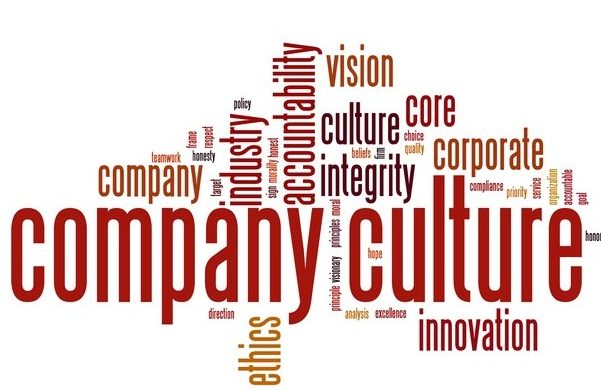
by Rich Finstein | Apr 26, 2017 | Blog
As many association leaders are aware, there have been quite a few changes over the past several years with technology related companies who serve and support our community. Recently it was announced that three leading AMS companies joined forces, with a fourth announced just today. Changes like this certainly alter the playing field and have decision makers rethinking their approach to the selection of learning management solution providers.
One of the less talked about impacts of mergers and acquisitions is how it affects company culture. In most cases clients have made a decision to contract with a company based on a level of trust that has been established with the people behind the solution. If the companies mission or culture changes, or the original owners are no longer there, the relationship could be impacted and there may be a gap from what was originally expected.
A healthy company culture assures a level of stability, quality, and an overall commitment to clients, all while working as a unified team. CommPartners has watched the transactions from a far, remaining committed to a friendly culture that has extended to our community of clients for over 24 years. We recognize that the continuity of our work, the relationships that we establish and conversations we have over many years provide tremendous value.
True partnerships do not arise automatically, but are only built through understanding our clients’ goals, pressures, and vision of success. Our clients have become an intimate part of our team and their insights and ideas drive our innovation.
Our client relationships define and provide the foundation of CommPartners culture, with benefits including:
- Responsiveness and the ability to be nimble, always putting client needs first.
- Consistency, where clients are able to work with the same CP staff members over a long period of time. Our average tenure is over 8 years.
- Continuity of support by understanding our client’s mission, history, getting to know their membership and attending their events.
- Commitment to the clients planned set of priorities. There are no competing forces or politics to take away from the core mission to support our clients’ objectives.
- Reliability in the platforms and solutions we provide.
There will most likely be many more mergers and acquisitions in the association sector to come. These changes can have a rippling effect, altering client relationships and culture.
At CommPartners, we are clear and unwavering about our mission, values and culture.








